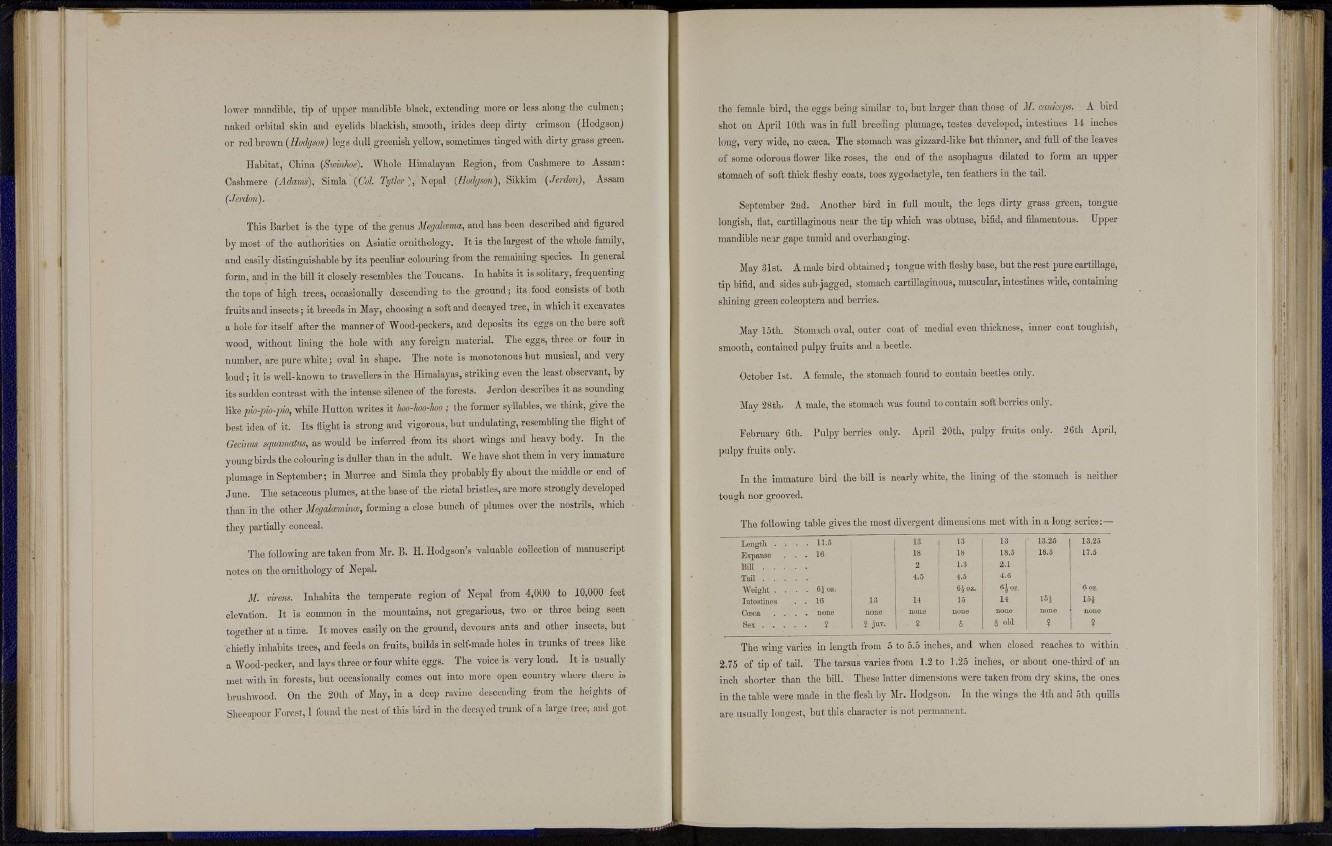
lower mandible, tip of upper mandible black, extending more or less along the culmen;
miked orbital skiii and eyelids blackish, smooth, irides deep dirty crimson (Hodgson)
or red brown (Hodgson) legs dull greenish yellow, sometimes tinged with d i r t y grass green.
Habitat, China (SwinJwe). Whole Himalayan Region, from Cashmere to Assam:
Cashmere (Adams), Simla (Col. Tytler ), Nepal (Hodgson), Sikkim (Jerdon), Assam
(Jerdon).
This 15arbet is the type of the genus Megakema, and has been described and figured
by most of the authorities on Asiatic ornithology. It is the largest of the whole family,
and easily distinguishable by i t s peculiar colouring from the remaining species. In general
form, and in t h e bill it closely resembles the Toucans. In habits it is solitary, frequenting
the tops of high trees, occasionally descending to the ground; its food consists of both
fruits and insects; it breeds i n May, choosing a soft and decayed tree, in which it excavates
a hole for itself after the manner of Wood-peckers, and deposits its eggs on the bare soft
wood, without lining the hole with any foreign material. The eggs, three or four in
number, are pure, white; oval in shape. The note is monotonous but musical, and very
loud; it is well-known to travellers in the Himalayas, s t r i k i ng even the least observant, by
its sudden contrast witli the intense silence of the forests. Jerdon describes it as sounding
likepio-pio-pio, while I l u t t o n writes it hoo-lioo-hoo ; the former syllables, we think, give the
best, idea of it. Its flight is strong and vigorous, but undulating, resembling the flight of
Gechius squamatus, as would be inferred from its short wings and heavy body. In the
young birds t h e colouring is duller than in the adult. We have shot them in very immature
plumage in September; in Murree and Simla they probably fly about the middle or end of
June. The setaceous plumes, at t h e base of the rictal bristles, are more strongly developed
than in the other Megakeminie, forming a close bunch of plumes over the nostrils, which
they partially conceal.
The following are taken from Mr. B. II. Hodgson's valuable collection of manuscript
notes on the ornithology of Nepal.
M. virens. Inhabits the temperate region of Nepal from 4,000 to 10,000 feet
elevation. It is common in the mountains, not gregarious, two or three being seen
together at a time. It moves easily on the ground, devours ants and other insects, but
chiefly inhabits trees, and feeds on fruits, builds in self-made holes in t r u n k s of trees like
a Wood-pecker, and lays three or four white eggs. The voice is very loud. It is usually
met with in forests, but occasionally comes out into more open country where there is
brushwood. On the 20th of May, in a deep ravine descending from the heights of
Sheeapoor Forest, 1 found the nest of this bird in the decayed trunk of a large tree, and got
the female bird, the eggs being similar to, but larger than those of M. caniceps. A bird
shot on April 10th was in full breeding plumage, testes developed, intestines 14 inches
long, very wide, no casca. The stomach was gizzard-liké but thinner, and full of the leaves
of some odorous flower like roses, the end of the asophagus dilated to form an upper
stomach of soft thick fleshy coats, toes zygodactyle, ten feathers in the tail.
September 2nd. Another bird in full moult, the legs dirty grass green, tongue
longish, flat, cartillaginous near the t i p which was obtuse, bifid, and filamentous. Upper
mandible near gape tumid and overhanging.
May 31st. A male bird obtained; tongue with fleshy base, but the rest pure cartillage,
tip bifid, and sides sub-jagged, stomach cartillaginous, muscular, intestines wide, containing
shining green coleóptera and berries.
May 15th. Stomach oval, outer coat of medial even thickness, inner coat toughisb,
smooth, contained pulpy fruits and a beetle.
October 1st. A female, the stomach found to contain beetles only.
.May 28th- A male, the stomach was found to contain soft berries only.
February 6th. Pulpy berries only. April 20th, pulpy fruits only. 26th April,
pulpy fruits only.
I n t h e immature bird the bill is nearly white, the lining of the stomach is neither
tough nor grooved.
The following table gives the most divergent dimensions met with in a long series:—
Length. • • . 11.5 13 13 13 13.25 13.25
Expanse . 16 18 IS 18.5 18.5 17.5
2 1.3 2.1
4.5 4.5 4.6
Weight . . . 6£ oz. 61 oz. 6 | o z .
I5i
6oz.
Intestines . 16 13 14 15 14 15J
Cceca . . nono nono none none none nono none
S e x . ' . . ? S juv. ? S S old ? ?
The wing varies in length from 5 to 5.5 inches, and when closed reaches to within
2.75 of tip of tail. The tarsus varies from 1.2 to 1.25 inches, or about one-third of an
inch shorter than the bill. These latter dimensions were taken from dry skins, t h e ones
in the table were made in the flesh by Mr. Hodgson. In the wings the 4th and 5th quills
are usually longest, but this character is not permanent.